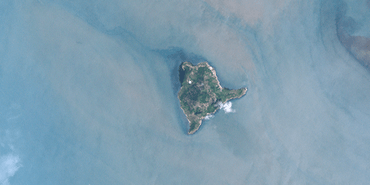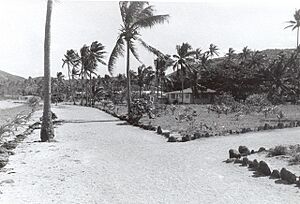Dauan Island facts for kids
Quick facts for kids Dauan IslandQueensland |
|
|---|---|

Aerial view of Dauan Island, 2011
|
|
| Population | 131 (2021 census locality) |
| • Density | 38.5/km2 (100/sq mi) |
| Postcode(s) | 4875 |
| Area | 3.4 km2 (1.3 sq mi) |
| Time zone | AEST (UTC+10:00) |
| LGA(s) | Torres Strait Island Region |
| State electorate(s) | Cook |
| Federal Division(s) | Leichhardt |
Dauan Island is a small island in the Torres Strait, which is part of Queensland, Australia. It is also known as Cornwallis Island. Dauan Island is both an island and a town, as well as a local area within the Torres Strait Island Region. In 2021, about 131 people lived on Dauan Island.
Contents
Discover Dauan Island's Location
Dauan Island is about 2.85 kilometers long and 2.7 kilometers wide. It is located 5 kilometers west of Saibai Island and 11 kilometers south of Papua New Guinea.
Dauan is part of the North Western Islands group in the Torres Strait. Boigu and Saibai Islands are the other islands in this group. The people from all three islands see themselves as one community.
This island group is very close to the border with Papua New Guinea. It marks the most northern point of Australia's land. Dauan is famous in the Torres Strait for its fresh water springs, rich soil, and steep hills. Its English name, Cornwallis, comes from Mount Cornwallis, which is Queensland’s most northern granite peak.
The traditional owners, the Dauanalgal (Dow-a-nal-gal) people, call it Dauan. They consider it part of the Great Dividing Range. People from Dauan, Boigu, and Saibai still have strong family and trade connections with coastal communities in Papua New Guinea.
A Glimpse into Dauan Island's Past
Kalaw Lagaw Ya (also called Kalau Kawau Ya, or KKY) is one of the languages spoken in the Torres Strait. It is the traditional language of the Top Western islands. This language area includes the land within the Shire of Torres.
Early European Visits
In 1792, Captain William Bligh visited the Torres Strait with his British Navy ships, Providence and Assistant. He mapped the main reefs and channels. Bligh named the island's highest hill Mount Cornwallis. Because Dauan was far from the main shipping routes, not many Europeans visited it before the 1860s.
The Coming of the Light
Torres Strait Islanders call the arrival of the London Missionary Society (LMS) on July 1, 1871, "the Coming of the Light." After visiting Erub and Tudu, missionaries like Reverend Samuel McFarlane came to Dauan on July 6, 1871. Nadai, the leader of Dauan, met them and allowed them to start a mission. Two teachers from the South Sea Islands, Josaia and Sivene, were chosen to be missionary teachers on Dauan and Saibai. When LMS missionaries returned in 1872, they found that Josaia and Sivene had been welcomed and given land by the local chiefs.
Pearling and Sea Cucumber Trade
In the 1860s, boats began collecting sea cucumbers and pearls in the Torres Strait. While no pearling bases were set up on Dauan, European pearl and sea cucumber businesses started hiring men from the North Western Islands in the 1870s. These men worked on their lugger boats.
Protecting the Islands from Raids
From the late 1870s, coastal villages in Papua and the islands of Dauan, Boigu, and Saibai faced attacks. Warriors from the Marind-anim or Tugeri people from West Papua would raid them. In 1881, a government ship called Pearl visited Dauan. They found that everyone from Boigu had come to Dauan for safety. The raiders had killed 11 Islanders and burned villages on Boigu.
Dauan was often a safe place for people from Boigu and Saibai. It was surrounded by reefs and strong currents, which made it hard for raiders to reach in their canoes. Government officials Henry Chester and Frank Jardine tried to stop the raiders but could not find them. Chester left firearms with the people of Boigu to help them defend themselves. By 1896, British officials helped reduce the threat, but some raids on Dauan, Boigu, Saibai, and Papua continued until the 1920s.
Queensland Government's Role
In 1872, the Queensland Government wanted to control more of the Torres Strait. The British Government agreed, creating a new colony that included all islands within 60 nautical miles of Queensland's coast. This area was later expanded in 1879 to include islands like Boigu, Erub, Mer, and Saibai. This new law helped the Queensland Government manage the sea cucumber and pearling industries.
Around 1900, Reverend Walker of the London Missionary Society started a business called Papuan Industries Limited. This company helped Islander communities rent or buy their own pearl luggers, known as "company boats." These boats were used to collect pearl shells and sea cucumbers, which the company then sold. By 1911, the people of Dauan had bought their first company boat, named Papua. Company boats gave Islanders income and pride. They also made travel and communication between the islands much easier.
In November 1912, the Queensland Government officially set aside 800 acres of land on Dauan as an Aboriginal reserve. Many other Torres Strait Islands were also made Aboriginal reserves at this time.
A government report from 1912 mentioned food shortages on Dauan and Saibai. It also said that only 12 to 15 people lived on Dauan permanently. By 1918, a Protector of Aboriginals was appointed to Thursday Island. During the 1920s and 1930s, strict laws about race were applied to Torres Strait Islanders.
In the 1930s, a mission school was started on the island.
Islander Rights and Self-Governance
In 1936, about 70% of the Torres Strait Islander workforce went on strike. This was the first organized protest by Torres Strait Islanders against government control. The strike lasted nine months. Islanders were angry about the government controlling their jobs and lives. They protested against rules about wages, trade, and evening curfews. They also wanted to travel between islands without permits and choose their own boat crews.
The strike led to important changes. The unpopular local Protector J D McLean was replaced by Cornelius O'Leary. He started a system where he regularly talked with elected Islander council representatives. The new island councils were given some power, including control over local island police and courts.
On August 23, 1937, O'Leary held the first meeting of Islander Councillors at Masig. Representatives from 14 Torres Strait communities attended. Mau and Anau represented Dauan at this meeting. After long discussions, unpopular rules like evening curfews were removed. A new way for local people to be represented was agreed upon.
In 1939, the Queensland Government passed the Torres Strait Islanders Act 1939. This law included many ideas from the conference. It officially recognized Torres Strait Islanders as a separate group of people from Aboriginal Australians.
World War II and Beyond
During World War II, the Australian Government asked Torres Strait Islander men to join the armed forces. Men from Dauan and other islands formed the Torres Strait Light Infantry Battalion. Even though they were respected soldiers, they only received one-third of the pay that white Australian soldiers got. On December 31, 1943, members of the Torres Strait Light Infantry went on strike. They demanded equal pay and equal rights for all soldiers. The Australian Government agreed to increase their pay to two-thirds of what white soldiers received. In the 1980s, the Australian Government offered full back pay to these Torres Strait servicemen.
After the war, the pearling industry in the Torres Strait declined. Islanders were then allowed to work and live on Thursday Island and the Australian mainland.
After gaining independence from Australia in 1975, Papua New Guinea claimed rights to the islands and waters of the Torres Straits. In December 1978, Australia and Papua New Guinea signed a treaty. This treaty set the borders between the two countries and explained how both could use the sea. Starting in February 1985, the Torres Strait Treaty allowed people to move freely (without passports or visas) between the two countries. This free movement is for traditional activities like fishing, trading, and family gatherings in a special Protected Zone.
On January 29, 1985, the Queensland Government opened Dauan Island State School. In 2007, the Tagai State College was created, and Dauan Island State School became the Dauan Island Campus of Tagai State College.
On March 30, 1985, the Dauan community elected three councillors. They formed an independent Dauan Island Council under the Community Services (Torres Strait) Act 1984. This law gave Torres Strait Islander councils powers similar to local governments. The council area, which was once an Aboriginal reserve, was given to the council on October 21, 1985.
In 2007, a government group suggested that the 15 Torres Strait Island councils be replaced by one Torres Strait Island Regional Council. In elections held on March 15, 2008, people from each of the 15 communities voted for a local councillor and a mayor. This created a council with 15 councillors and a mayor.
Dauan Island's Population
In 2016, Dauan Island had 191 people living there. By 2021, the population of Dauan Island was 131 people.
Community Facilities on Dauan Island
The Torres Strait Island Regional Council runs an Indigenous Knowledge Centre (IKC) on Main Street. It opened on June 30, 2006, in partnership with the State Library of Queensland. The IKC offers library services to the community. It also runs projects like "Taking IT On," "Remote Indigenous Public Internet Access (RIPIA)," "Culture Love," and "Deadly Digital Communities."
"Culture Love" was a project that helped capture and improve Aboriginal and Torres Strait Islander culture and history. It was a partnership between Arts Queensland, the State Library of Queensland, and local councils. At Dauan, "Culture Love" took place from July 2 to 6, 2013. Community members, children, young people, Elders, local artists, and visiting art workers celebrated culture through art. At the end of the week, they created an interactive book called The Coming of the Light Dauan Island. This book has original artwork and tells the story in both Kala Kawaw Ya (KKY) and English.
Education on Dauan Island
Dauan Island Campus is a primary school for children from early childhood to Grade 6. It is part of Tagai State College, which has its main office on Thursday Island (9°24′49″S 142°32′23″E / 9.4136°S 142.5396°E). In 2016, the Dauan campus had 18 students in early years and 21 students in middle years, making a total of 39 students.
Religion on Dauan Island
In 2018, a church on Dauan Island became the first in the Torres Strait to join the Personal Ordinariate of Our Lady of the Southern Cross. This is a special group within the Catholic Church for former Anglicans. A former priest from the Church of Torres Strait, Fr G.W. Barnier OLSC, became a Catholic deacon on April 24, 2013, and a priest two days later on April 26, 2013. He was ordained by James Foley, the Bishop of Cairns.



